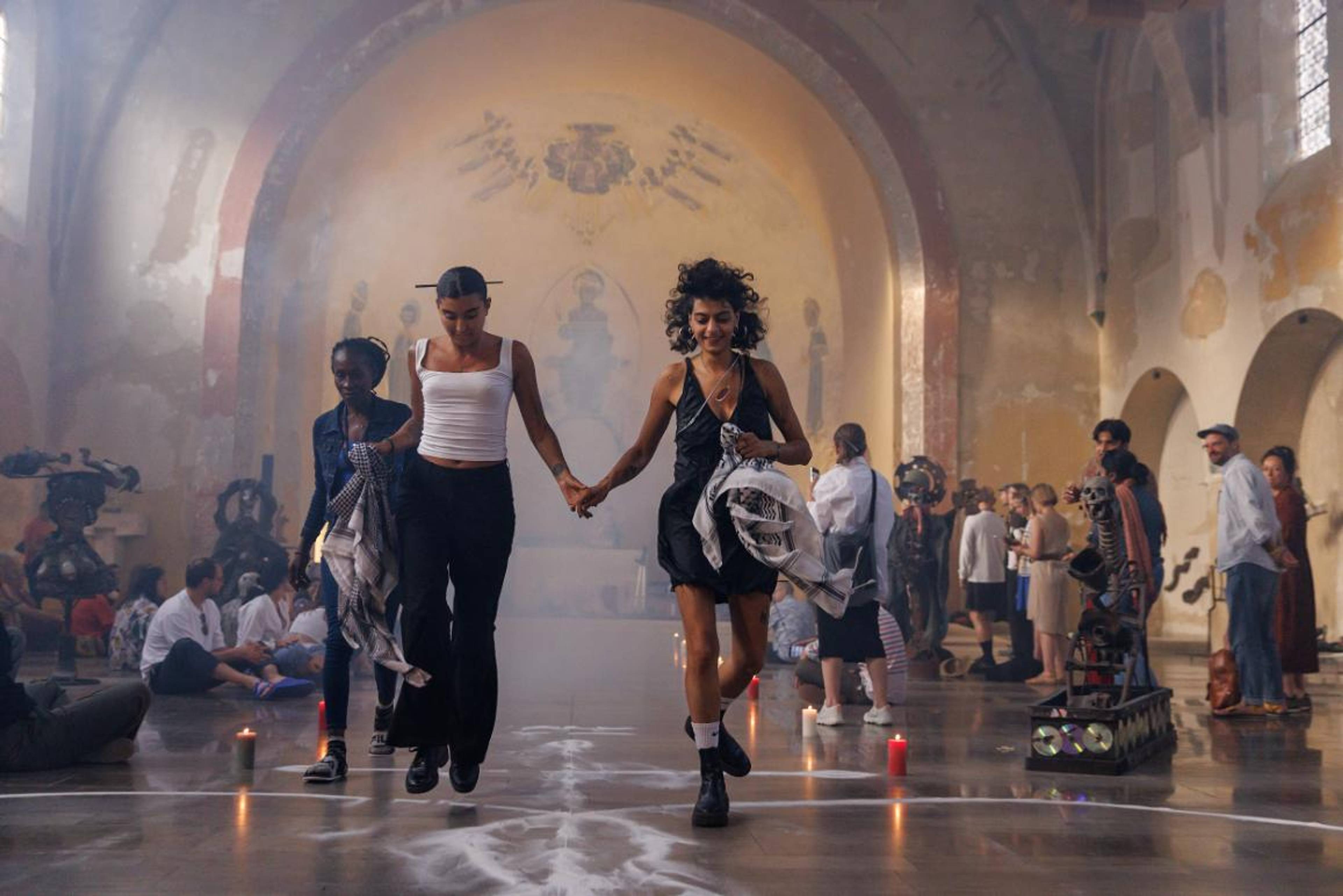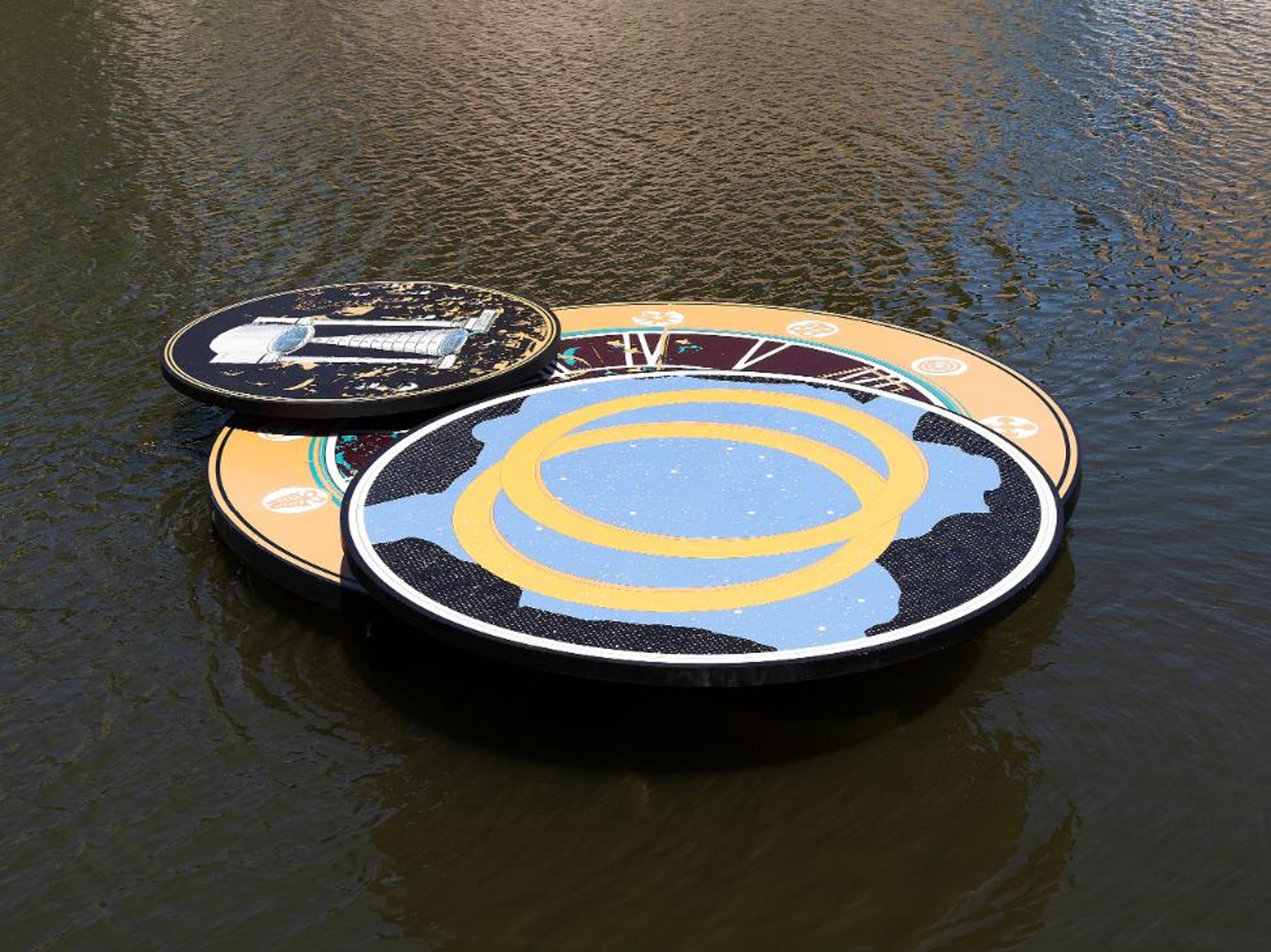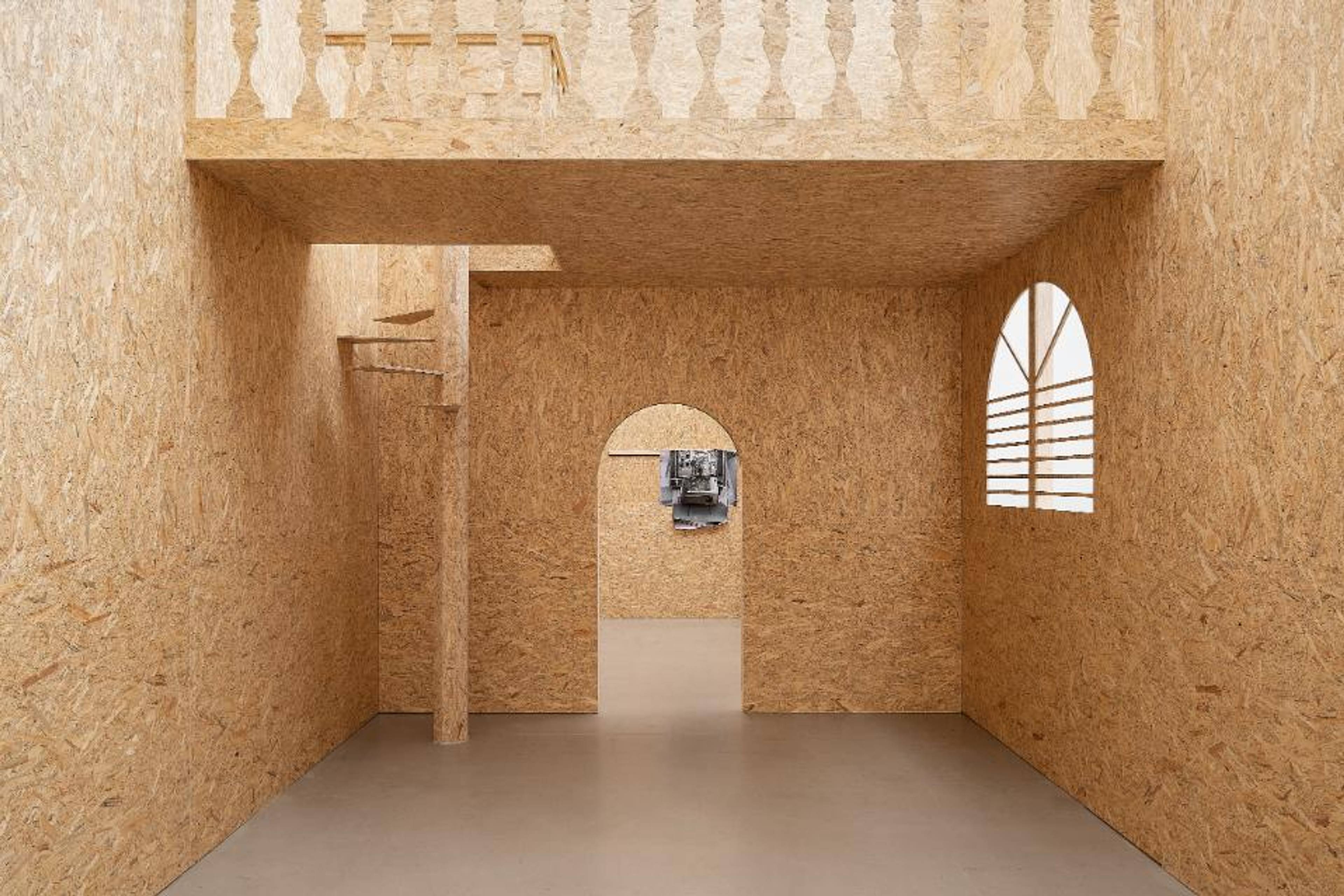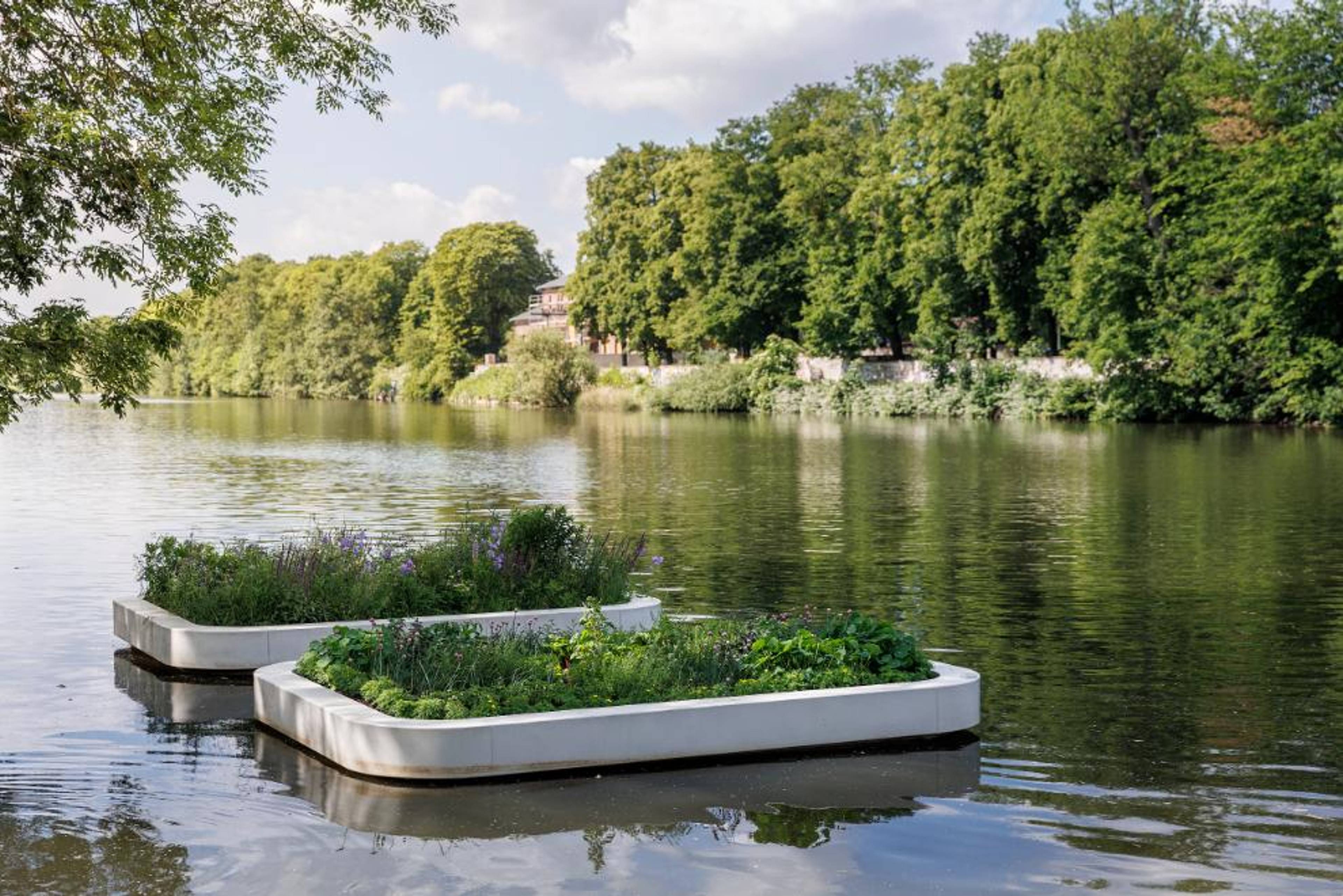SPIKE: What was the most impressive thing you saw at documenta fifteen?
Mohammad Salemy: The most impressive body of work was the video program by the regrouped Sada collective from Iraq. Sada – an initiative conceived by Rijin Sahakian that operated in Baghdad from 2011 to 2015 – supported artists facing the challenges of making and displaying art in a country after cycles of American-led war, sanctions, and political violence. One after another, these films give viewers a unique window into the life of a devastated country through the prism of its artistic production. The participating artists are Sajjad Abbas, Bassim Al Shaker, Layth Kareem, Ali Eyal, Raed Mutar, Sarah Munaf. Also exhibited is Sahakian’s own film, narrated powerfully with her own voice. In this film, the complicity of Arab monarchies in causing and supporting wars in the Middle East is explained in terms of rich but undemocratic nations like Saudi Arabia, United Arab Emirates, and Kuwait helping to destroy or weaken traditional centers of Arab culture like Baghdad, Damascus, Beirut, and Cairo, so that cities like Dubai and Sharjah can claim themselves as centers of new and contemporary Arab culture. The program was so powerful that it compelled me to stay and watch it twice in a row, and I usually skip most video art at biennales and other large group shows.
Andrew Berardini: Amol K Patil’s installation in the basement at Hubner Areal. Atmospheric, beautiful, poetic, strange, humorous, and tragic, a rare moment for me in this documenta. The layered shadowplay of Nguyen Trinh Thi in the Rondell. And to me both Atis Rezistans | Ghetto Biennale at St. Kunigundis and the OFF-Biennale Budapest contributions felt at turns astonishing to me.
Atis Rezistans | Ghetto Biennale Veve Kunigundis and Jann Pase’l Pase & Mache Nap Mache. Performance view, St. Kunigundis, Kassel, 17 June 2022. Photo: Frank Sperling
Nathalie von Veh: I was most struck by the illustrated timeline of their process in the basement of ruruHaus. It’s impressive because it gives you a sense of the true scale of the project, the number of people involved, the intentions behind every collective decision, and the number of challenges that they faced over the two-year process of building relationships and ideas — many challenges we all have faced together, globally. It also felt particularly refreshing for them to be so honest about their mistakes and disagreements, the true challenges of trying to work outside of institutions while caring for everyone, and to build relationships that can transcend documenta. Anyone who has ever facilitated or participated in collaborative work will recognize some of these same challenges, and how impressive it is to attempt to hold this at this scale. To me, this timeline illustrates the collective process (lumbung) better than any stand alone work can, and gets to the heart of what makes this iteration, and their effort, so special.
Edwin Nasr: I was very much enlivened by the propositions of Amol K Patil, Marwa Arsanios, Nguyen Trinh Thi, Hamja Ahsan, Kiri Dalena, Atis Rezistans, and Black Quantum Futurism — which is to say that, for better or worse, I did find myself mostly drawn to modes of art-making and forms of presentation I knew how to understand and engage through aesthetic, speculative, and poetic terms. Despite ruangrupa’s curatorial ethos being predicated on imagining infrastructural conditions for the collective production of artworks — rather than by what an artwork tends to convey in and of itself — most of the artists I mentioned were able to produce works that nevertheless attended to the inquiries set forth by this edition through diagonal lines.
For example, Arsanios’s Who is Afraid of Ideology? (Part 4) was a perfectly fitting meditation on commoning, using the Marxist notion of ‘metabolic rift’ and partaking in a rigorous study of inherited Ottoman laws to speculate on ways to collectivize a plot of land in Lebanon. Others relied more on the sensorial and the comical to make sense of what ‘collective sharing’ might even entail to begin with. Here, I’m thinking of Black Quantum Futurism, whose installation Black Grandmother Clock (Oral Futures Booth) (2021) collects visitors’ testimonies about the future, creating an open-source repository of feelings — a kind of ‘affective’ archive in the making, if you will; and Ahsan’s dispersed logos for an imagined fried chicken franchise, at once hilarious and heartbreaking, which mobilizes signifiers of collective belonging to draw a sharp critique of Islamophobia in Fortress Europe.
Black Quantum Futurism, Clepsydra Stage, 2022. Installation view, documenta fifteen, Kassel. Photo: Nicolas Wefers
Sada, The Question of Funding, The Nest Collective, and The Black Archives also managed to present strong and memorable work. I was especially excited to see The Black Archives had opted to privilege their research into the legacy of Surinamese thinker Otto Huiswoud – one of the more fascinating anti-colonial figures the world has known – and his foundational role in the establishment of the Communist Party USA. In turn, The Question of Funding, Sada (led by Rijin Sahakian), and The Nest Collective posed critical questions around, respectively, economies of aid and development in Palestine and the broader Arabic-speaking region, the complicity of Western museums with the occupation and pillaging of Iraq, and the global distribution of waste with a subtle sense of urgency I was unfortunately unable to locate elsewhere.
Otherwise, and I’ll be honest here, I did find it difficult, if not entirely futile, to assign a judgment of taste to a majority of the ‘output’ on display at documenta fifteen. I even remember remarking to a friend that doing so is like taking on the role of a grants officer at the Open Society Foundations deciding whether or not a project proposal is worthy of financial support. More on that below.
Övül Ö. Durmusoglu: First of all, I find the categorical approach of what is most and what is least is unfair and dysfunctional for the kind of exhibition lumbung process and majlises have become for documenta fifteen.
What is delivered in the exhibition format is almost encyclopedic, sharing with the audience strategies, tips, feelings, moments, spaces, and productions which don’t always take the taken for granted artistic work form. Let us not forget that the representation as understood in the Western epistemology has been one of the main instruments of colonial oppression in different parts of the world for centuries whether it is North or Latin America or Southeast Asia, gradually erasing people’s languages and ways of expressions in their everyday life. Therefore, the question of representation is part of the inequalities and power edifices Western civilizations produced. We always call it the art world but in reality it is made of so many worlds and they rarely intersect. So here is a large intersectional and co-habitational perspective of how art takes shape as non-imposed communities with its failures and victories. Various funders from Europe and elsewhere continue to impose forms as part of their requirements in that setting. The question is more “Where do we go from here?” and “What else do we need in our toolbox to deal with today?”
Decolonial is not a word, it is a practice of living that formulates itself in the context, on the ground, without necessarily thinking how it would become decolonial
Today, “decolonial” is in the lingo of major institutions. Yet the expressions of those decolonial exercises rarely appear as unlearning forms and representations. In 2012, Eve Tuck and K. Wayne Yang stated, “decolonization is not a metaphor.” Decolonial is not a word, it is a practice of living that formulates itself in the context, on the ground, without necessarily thinking how it would become decolonial. Now, with documenta fifteen, we experience a confrontation between practitioners of decolonization and mentioners of decolonization. Of course it is not an easy one as reflected in the tone of public discussions in Germany at the moment.
Instituto de Artivismo Hannah Arendt (INSTAR), Espacio Aglutinador, 2022. Installation view, documenta fifteen, Kassel. Photo: Nicolas Wefers
SPIKE: What was the most distressing thing you saw at documenta fifteen?
MS: Nothing has ever offended me while visiting large group exhibitions more than what ruangrupa did to the ground floor of Fridericianum. There’s the ugly childcare aesthetics of the entire floor, the refusal to create an architecturally pleasing environment for children’s play and instead recreating the familiar heteronormative concepts of having children in a family, and, even worse, of accompanying your little beasts with you to child-specific art facility that does nothing to elevate the sense of aesthetics and appreciation of a space other than whatever children already know and have experienced as their designated spaces which are already built into the miserable life of most children caught in their parents’ pathetic lives. One also must consider what it means to take the prime real estate of such an event, its main exhibition hall, holding the memory of exhibiting thousands upon thousands of great artworks and exhibitions in the past, and defacing it with the ugliest of all possible spatial arrangements. The rest of the floor was packed with out of context paintings by Richard Bell, an Aboriginal artist from Australia whose works dealing with land claims and Aboriginality felt completely out of place since they had very little to do with the reality of colonial relations in which non-Germans like myself find ourselves. Aside from their displaced political message, these paintings, executed pretty much like color by number children illustrations, might be useful as agitprop to raise the profile of Aboriginal claims over land and political power, but they add little to the history of painting or the theory of image and photography to which they relate.
AB: Distressing? Curious word choice, on a moment to moment basis, this documenta wasn’t distressing per se, it was mostly tapioca, i.e. too amorphously, gelatinously sweet to be truly distressing. I saw this documenta after the horror show of the Berlin Biennale and was thus a little battered by a certain didacticism that was certainly present in Kassel but not head-bashingly so.
But after seeing about thirty venues (of around forty), I did get distressed. Really distressed even. I felt hungry for something I couldn’t find. I got saddened by all the effort I’d made to be there to see so many messy community centers and heavy archives, anodyne skateboard half-pipes and poorly built saunas. I traveled five thousand miles to do karaoke. That’s when I really sort of gave up and went swimming in the river. I made some new friends there, maybe that was the point of the whole show.
I was distressed by how such a well-meaning high concept could produce such poor quality art. I was distressed that the decentered model of curating seems to mean that the curators don’t actually look at the art (most evident in regards to the anti-semitic depictions in the Taring Padi billboard/mural/painting). I was distressed by the saccharine, summercamp, actively anti-aesthetic dictate of “Make friends not art” (which is the last line of the introduction in the documenta fifteen handbook, and is repeated throughout the book). It’s a really sweet thing to say in its way, but isn’t for me a methodology that leads to good art.
There is an argument to be made that Europe generally only pretends to care about art from outside the North American/European spheres, but either ruangrupa failed to respond to its audience or they/documenta didn’t succeed in contextualizing this enough for me. I’d be curious how actually popular it is with the public, but I predict documenta is going to have to defend its funding for the next edition.
I’m really thrilled to hear that many people got as much out of this documenta as they did and I wouldn’t want to yuck their yum. I also found moments here and there of meaning to take away, but I ultimately felt that this documenta for all its gentle vibeyness to be disappointing and underwhelming. I enjoyed that there were plenty of places to chill, but that feels like a rather low bar for what was billed to me as the most important art exhibition in the world.
Britto Arts Trust, ছায়ািছব (Chayachobi), 2022. Installation view, documenta fifteen, Kassel, 2022. Photo: Nicolas Wefers
And I think it’s very meaningful that art for the participants can be a mode of survival against oppression, but the collective, surplus expression of this held very little poetry for me.
I walked into offices filled with people who didn’t engage me, past more stoney jam-sessions than a hippie picnic, into galleries that looked like storage rooms, and witnessed more mindmaps than I ever need to see in this lifetime. I kept ranging about, looking for something strange, unusual, transcendent, beautiful, and found a few pretty authentically heartbreaking works, works I felt I was really seeing something artful, but mostly it felt like a vibey mess. More of a bazaar of community centers justifying their NGO financing than an art show. And perhaps that was the point. Maybe I failed as a participant observer in looking for the wrong thing.
(And deep apologies if this comes off as cranky/ranty, I really, authentically did want to connect with the show.)
NvV: I think some of what makes documenta so special, and magical at times, are also what can make it distressing, as Andrew alluded to here. It’s just a lot. There’s so much going on and too little resources spread over too many people. I think that for the spirit of collectivity to be honored, artists and organizers have to do less or be given more resources. To me, the staff seemed overwhelmed and tired, a lot of them were apparently sick with Covid-19, and as an audience member, it is just a lot to behold and process. Even with rest rooms. There is so much good art, but it can get lost because there are so many venues, so much writing and information, and each collective work requires a lot of time to time to fully participate or take in. I hope that all the participating artists walk away with something profound and meaningful, because I like the concept “make friends, not art” and I do genuinely believe there is something here that we are all craving to be a part of. But we can’t build alternative models of working together without considering if we are simply taking on too much with too few resources.
EN: I know it’s become redundant at this stage to call the whole thing overwhelming and inconsistent, but when exposed to the kind of unmediated dissonance and ideological flimsiness this edition sometimes tends to unfortunately provide and invite visitors to project on, you can’t help but rehash that complaint.
Let me start by unpacking what I meant when I said that navigating — and attempting to assign a judgment of taste or value towards — a majority of the output produced and exhibited by invited collectives made me feel like an OSF grants officer. Firstly, I’m unconvinced by the generalized and uncritical use of the term ‘collective’ to describe the participating formations in this edition of documenta when many of them, including ruangrupa themselves, either present informal or situational institutional arrangements or are time-served institutions. This isn’t to say I’m arguing for us to ascribe a negative connotation to organizational forms here, but I do think it’s important we recognize and name institutional structures and behaviors for what they are instead of romanticizing their idiosyncrasies and informalities due to the geographical location where they operate.
OFF-Biennale Budapest, Ilona Németh, Floating Gardens (Future Garden & Healing Garden), 2011-22. Installation view, documenta fifteen, Kassel. Photo: Frank Sperling
I also think that distinction is worth making because it brings us to resource allocation and funding, both of which are at the heart of ruangrupa’s curatorial framework and concerns, but also that of Arts Collaboratory (AC), “a self-organized ecosystem of 25 independent art organizations in Africa, Asia, and Latin America,” which includes ruangrupa among several other participating groups and played a pivotal role in shaping this edition of documenta. AC is funded by the DOEN Foundation in the Netherlands, and most of its member organizations receive their structural funding from similar state-sponsored formations in Europe, among them the Institut Français and Goethe-Institut, and private foundations in the US, including Ford Foundation and Open Society Foundations. As valuable as it is to gather around and estimate notions and practices of self-sustenance, organizational autonomy, and collective sharing, I find it of equal importance to provide the necessary historical contextualization to understand how, why, and to which extent a lot of these collectives and institutions are dependent on and sutured into the mechanisms of Euro-American soft power and development aid. Now, some of ruangrupa’s detractors have used this against them — I’m not interested in doing so at all, and I find this line of reasoning to be problematic, if not outright desperate. To seek external funding in the Global South today in order to build critical, life-affirming networks and organizations in no way repudiates the potentialities of these initiatives and the political agency they might find themselves exercising. But I do genuinely deem it crucial that we identify and examine the type of economies through which a majority of the cultural formations and expressions in documenta fifteen manage to survive, both in order to imagine ways out of these dependencies — something the Question of Funding has been aptly working on — or at least to render more complex prevailing discourses around the exhibition, which I currently find suffering from both mystification and ahistoricism.
I felt like most of the collectives and institutions producing them were somehow stretching themselves too thin so as to secure future grants from state and private agencies.
This also brings me to what some have been dubbing ‘NGO aesthetics’ in relation to the output on display across different locations in Kassel, and which I was also referring to at the beginning of my intervention. I did actually feel ‘distressed’ when faced with a crushing abundance of mindmaps, workshop platforms, recorded logs from collective discussions, photo and video documentation of activities etc. not because I was concerned with whether or not this constitutes “art,” but because I felt like most of the collectives and institutions producing them were somehow stretching themselves too thin so as to secure future grants from state and private agencies. It also felt like that kind of output wasn’t particularly there to be engaged with, only acknowledged, and rather demonstratively so, as some sort of physical marker of accumulation and hyperactivity. It sometimes felt like it was mirroring the institutional dictate that, the thicker your annual report is, the more likely you are to have your funding renewed.
Enthusiasts insistently framed this edition of documenta as a remedy against Cecilia Alemani’s Venice Biennale and its uncomfortable proximity to the art market and renewed celebration of the objet fétiche. In more ways than one, they might as well be right, but I would caution against heralding forms produced and mediated through cultural diplomacy as some sort of radical countermeasure to that tendency. I truly appreciate the enthusiasm generated by this edition of documenta — in fact, I believe it to be one of the more thought-provoking curatorial propositions towards care and mutuality I’ve ever had the chance to come across — but I miss the analyses that engage it in a sobering and rigorous manner, as I’m sure ruangrupa and the artistic team would want it to be. There has just been too much senseless exaltation by guilt-ridden art professionals pleading mea culpa.
OFF-Biennale Budapest, Eva Koťátková, Daydreaming Workstation, 2022. Installation view, documenta fifteen, Kassel. Photo: Frank Sperling
___
To read up on Documenta’s many scandalous mishaps, click through to part two of this roundtable.








